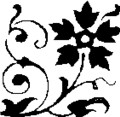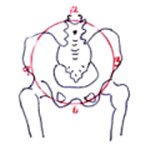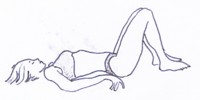All the therapies and techniques described on these pages are ones I have experienced myself, and while descriptions of techniques are factual, all opinions are personal.
All the therapies and techniques described on these pages are ones I have experienced myself, and while descriptions of techniques are factual, all opinions are personal.

Moshe Feldenkrais was trained as an engineer, and viewed the body as a machine which could be programmed to work with minimum effort but maximum efficiency. The brain develops an 'image' of how movements should be made from infancy onwards: if the image is in any way faulty, unnecessary strain is produced on muscles and joints. Feldenkrais therefore devised exercises to develop new patterns in the brain, and called these AWARENESS THROUGH MOVEMENT. Taught in classes, these gentle exercises are intended to make people aware of their habitual patterns and of new possibilities.
The lessons are designed to improve posture and hence breathing, circulation, and general well-being. A Feldenkrais Workshop is also great fun - learning-through-doing how you, as a baby, originally used your own inertia to roll over, then sit up, then learn to crawl! How different crawling would feel if you moved as an elephant moves, both limbs one side moving together instead of alternately...how much more easily you can rise from sitting to standing if you time your weight instead of unconsciously straining...how to 'listen' to your body and use its natural skills. Used by athletes, dancers, sportsmen, and others whose life involves a great deal of movement, the Feldenkrais exercises are also of great value to post-stroke victims, people with arthritis, rheumatism, chronic back pain etc. There are also Feldenkrais voice workshops particularly designed to relax the throat, shoulders and chest so as to use resonance and breathing to best advantage.
It is also possible to have one-to-one treatment by a Feldenkrais teacher giving gentle manipulation in a system called FUNCTIONAL INTEGRATION. Feldenkrais teachers can be found through the Feldenkrais Guild, in London UK, and other centres.
An example of a Feldenkrais exercise is given below. This one is perhaps the most well-known, and is called The Pelvic Clock or the Feldenkrais Clock. From experience, I can say that it loosens any stiffness in the pelvis and improves general movement, and also provides relief from backache. The exercise, like all Feldenkrais exercises, should be done gently and only to the limit of each doer's capacity, without strain.

Imagine that fixed on the back of your pelvic girdle is a clock dial. 6 o'clock is at the lowest point  and 12 o'clock is at the highest point. 3 o'clock is at the right hip-joint and 9 o'clock is at the left hip-joint.
and 12 o'clock is at the highest point. 3 o'clock is at the right hip-joint and 9 o'clock is at the left hip-joint.
The same dial is superimposed on the face with 6 at the chin, and 12 at the top of the head. The head rotates round the dial in the same way as the pelvis, mimicking its movements. For instance, at 6 the chin is tucked in, at twelve the head tipped back; at 3 and 9 and head turned to the side; and so on.
 Lie on the floor with knees up and bent, feet flat on the floor. Lift the lower back from the floor, putting pressure on the 6 o'clock point. Rock back to put pressure on the 12 o'clock point. Repeat several times, smoothly and easily; then relax.
Lie on the floor with knees up and bent, feet flat on the floor. Lift the lower back from the floor, putting pressure on the 6 o'clock point. Rock back to put pressure on the 12 o'clock point. Repeat several times, smoothly and easily; then relax.
Tilt the pelvis to 3 o'clock, then to nine o'clock; repeat.
Starting with pressure at 12 o'clock move to 1 o'clock, then back. To 2 o'clock, then back. And so on, until rolling from 12 to 6 and back. Relax.
Do the same thing the other side. Relax.
Rotate all round the clock, first in one direction, then the other. Relax.
This completes the exercise. Stand up and see whether you can feel greater mobility in your pelvis. It is probable that you will do so, as well as a greater awareness of what the pelvis is doing as you move and walk.
For Metamorphic Technique and Healing Sounds from previous issues, click on Archive